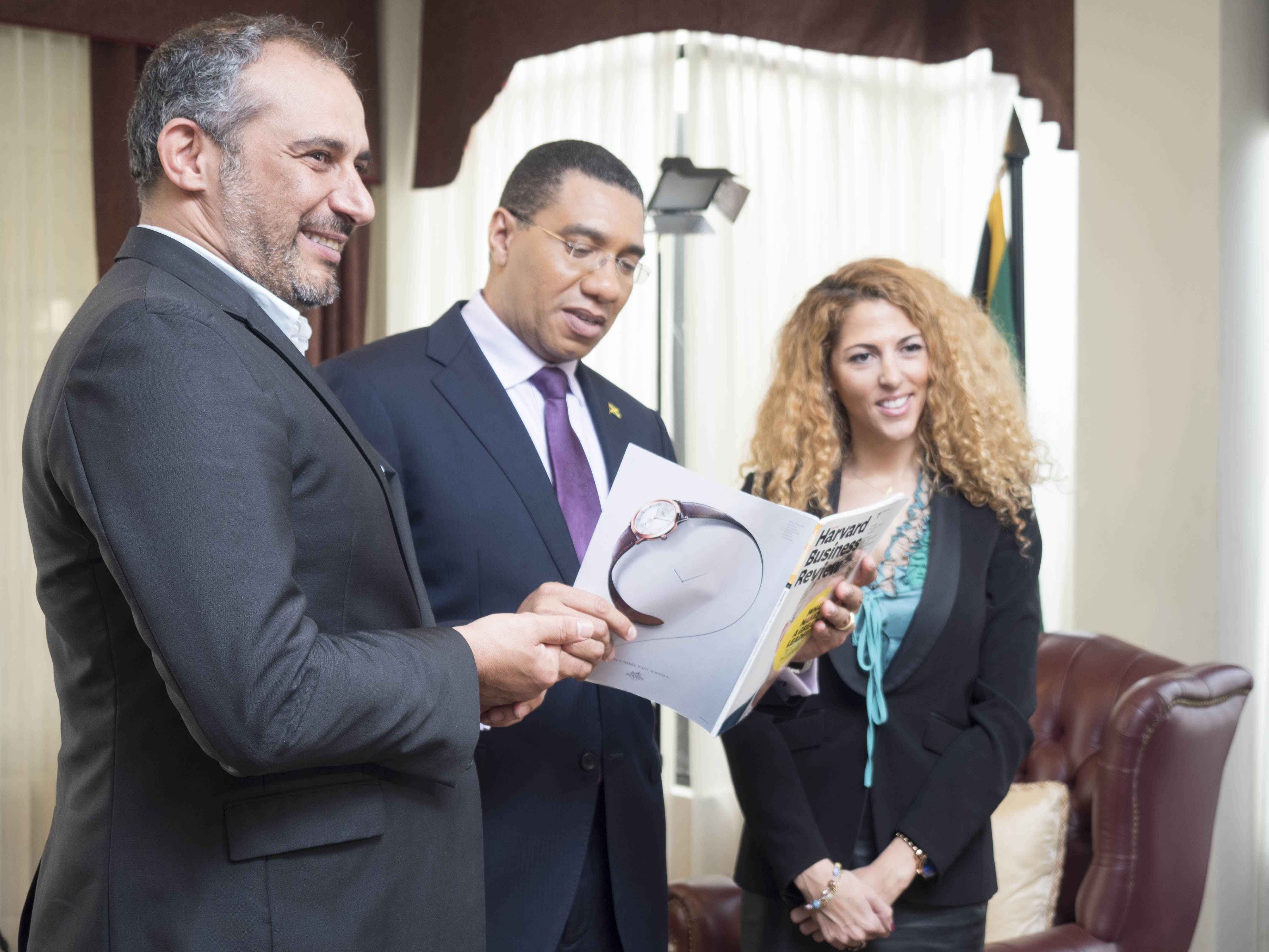Jamaica embarks on an economic transformation, building logistics and BPO sectors as new pillars for sustainable growth.
Attracting over two million visitors a year, Jamaica has among the strongest and most diversified tourism products in the Caribbean region. The sector accounts for over half of the country’s foreign exchange earnings, one quarter of GDP and of employment. But after decades of slow and sometimes negative growth, the country is taking a strategic turn, with plans to leverage its countless other strengths — including its key geographic location and the largest English-speaking workforce in the Caribbean — to transform, diversify and strengthen its economy.
Located at the center of the Caribbean, right outside the Panama Canal, Jamaica is at the crossroads of North-South and East-West shipping lanes and plans to join Singapore, Dubai and Rotterdam as the fourth node in global logistics.
“Jamaica can be a crossroads for the rest of Latin America, Central America, South America, into North America.” — Andrew Holness, Prime Minister of Jamaica
Since taking office in March of 2016, Prime Minister Andrew Holness has established an Economic Growth Council, headed by investor and philanthropist Michael Lee Chin, chairman of the National Commercial Bank of Jamaica (NCB), to advise the government on the best economic policies with a goal of reaching 5% annual GDP growth by 2020.
With a population of 2.8 million — roughly equivalent to that of Chicago — Jamaica has the largest workforce in the English-speaking Caribbean. To further take advantage of this strength, the Andrew Holness Administration has implemented a long-awaited educational reform slated to take effect at the start of the 2017 school year. A key part of this reform was the establishment of Spanish as the second national language.
With many areas of rich, untapped potential, Jamaica does not come without its challenges. The most prominent is its high crime rate and insecurity — Kingston is said to be among the most dangerous capitals in the world. Tackling this issue is therefore a crucial component of the country’s ongoing socioeconomic transformation.
An Overdue Economic Reform
The first step to solving a problem is recognizing it. Jamaican leaders readily acknowledge the country’s growth has been less than stellar since its independence.
“Jamaica is blessed with an abundance of natural resources and human potential but somehow, these have not been converted to sustainable economic growth for the majority of our independent experience,” says Economic Growth Council (EGC) Chairman Michael Lee Chin. Jamaica Chamber of Commerce President Warren McDonald seconds this assessment in a report by the EGC, “Jamaica’s poor track record of economic growth since our achievement of Independence is evidence that the many initiatives that we have attempted nationally have not borne fruit to any significant level.”
Following Mr. Holness’ 2016 election campaign, the slogan of which was “From Poverty to Prosperity,” the newly elected prime minister promised a new strategy to achieve sustainability, to be kick started by the newly established EGC, and sustained in the long term by an educational reform to ensure a highly-qualified workforce.
“The quality of the education a child receives, will impact the quality of human resource input in the economy,” he said in February 2016. He added, “We may not all be rich, but no one has to be poor.”
In September 2016, the EGC published a set of policy recommendations known as the eight Growth Initiatives with the ambitious objective of reaching 5% annual economic growth by 2020, known as the “5 in 4.”
“The seeming inability to achieve appreciable levels of economic growth now threatens the social fabric of Jamaica,” said EGC Chairman Michael Lee Chin, recognizing the urgency of a profound economic reform.

Prime Minister Andrew Holness in a meeting with World Investment News CEO Pascal Belda and World Investment News Vice President of Sales Stephanie Huertas at the Prime Minister’s offices in Kingston, in April 2016. — Photo: Stan Aron for World Investment News
Economic Growth Council Initiatives
Maintain Macro-Economic Stability and Pursue Debt Reduction
“Economic growth and fiscal responsibility are not mutually exclusive,” says the EGC, which recommends a successor arrangement to the IMF’s economic support program, enhancing the credibility and flexibility of the exchange rate regime, and pursue debt for asset swaps in order to accelerate Jamaica’s rate of debt reduction by 2 or 3 percentage points.
Improve Citizen Security and Public Safety
The EGC recognizes insecurity in Jamaica as having deterred investment, destroyed capital formation, and discouraged business development. “Improving citizen security is the single most important growth-inducing reform that Jamaica can undertake,” the report says, recommending a restructuring of law enforcement agencies, a criminal justice reform, as well as addressing the social causes of crime and violence.
Improve Access to Finance
To promote more financial risk taking, which vibrant economies require, the council recommends a number of regulatory reforms, such as reducing minimum capital test requirements for insurance companies, developing new housing finance solutions for lower income households, strengthening the venture capital and angel investor ecosystem, and bringing the taxation of financial services in line with other sectors.
Pursue Bureaucratic Reform to Improve the Business Environment
Tackling bureaucratic inefficiency, the EGC recommends streamlining processes for small businesses employing fewer than 10 people, faster application and permitting approvals, improving courts’ efficiency in areas such as contract enforcement, extending the hours to process more matters, and simplifying import-export procedures.
Stimulate Greater Asset Utilization
To keep assets from remaining dormant, which generates only small returns and does not contribute to jobs or employment, the EGC advises implementing mechanisms that promote greater utilization of these assets to induce economic growth. This would include promoting privatization, public-private partnerships, and similar transactions.
Build Human Capital
Considering education and training deficiencies for high skilled workers as one of the main causes of low productivity, the council recommends training programs aligned with the labour market as well as financing such as loans, incentives and grants. They also favor further work and recommendations by the Labour Market Reform Commission (LMRC).
Harness the Power of The Diaspora
Jamaica’s diaspora, estimated to be equivalent to the country’s entire population, is the second largest of any Caribbean nation, after the Dominican Republic. Already the largest source of foreign exchange, they could play a greater role in investment, knowledge transfer and mentorship, through engagement policies using the Jamaica Diaspora Foundation.
Catalyze the Implementation of Strategic Projects
A number of strategic projects could yield long term benefits for the country, such as establishing Special Economic Zones, redeveloping downtown Kingston, expanding the BPO sector, resorts and other major tourism projects, agro-processing projects, and improving infrastructure such as highways and renewable energy.
Immediately after taking office, Mr. Holness met with the International Monetary Fund (IMF) to discuss an economic support program aimed at reducing the country’s debt.
Indeed, following the 2008 global economic crisis, the Jamaican dollar (JMD) fell off a cliff, dropping by 17%, in the space of six months. With the compounded impacts of the crisis and the passage of Hurricane Sandy which hit the country in 2012, the currency has continued to depreciate, while Jamaica’s public debt rose from 110.9% of GDP in 2007 to 136.6% in 2015, through lending by the World Bank, the Inter-American Development Bank (IDB) and the IMF for a total of nearly US$2 billion.
By March of 2016, when the new Jamaica Labour Party (JLP) administration took office, however, it had dropped to 120.2%, better than the projected 125.1%, according to data from the Ministry of Finance.
“We are emboldened by our recent collective experience where the application of societal resolve towards achieving fiscal sustainability has borne much fruit,” said Mr. Lee Chin of the encouraging trend in dept-to-GDP ratio.
The government and the IMF reached an agreement in October 2016 for a three-year successor program to extend the Extended Fund Facility (EFF) slated to end in 2017. This new program includes a US$1.7 billion “insurance policy” against unforeseen economic shocks.
“Our request to move to a precautionary arrangement is a sign of strength and reflects the policy credibility and strong macroeconomic management of the Jamaican government,” Mr. Holness told the Jamaica Information Service (JIS).
Since 2009, Jamaica’s credit rating has improved from CCC to B (S&P and Fitch), and from Caa1 to B3 (Moody’s), while Bloomberg ranked Jamaica’s stock exchange as the best performing in the world.
“I’m really impressed with what they’ve done to attract capital to the market,” Carl Bennett, a vice president of investor relations at Bank of New York Mellon, told Bloomberg.
Did You Know?
- Rum is Jamaica’s national drink
- British writer Ian Fleming, of James Bond fame, built his house named Goldeneye in Jamaica
- The first piece of land Christopher Columbus saw on his second journey to the New World in 1494 was the tip of the Blue Mountains
- The fastest man and woman in the world, you guessed it, are both Jamaican – Usain Bolt and Elaine Thompson
- Jamaica was the first tropical country to enter the Winter Olympics, inspiring the bobsleigh film Cool Runnings
- Jamaica has the only national flag in the world that does not share any colors with that of the U.S.A.
Photo: Howard Jefferson
More content about Jamaica soon
Our Team in Jamaica
Stephanie Huertas
Vice President for the CaribbeanAlberto de la Mota
Web IntegratorOmar El Asfari
Project DirectorStan Aron
Editor-in-ChiefDaria Teresa
Business Development ExecutiveElena Costa Krämer
Creative DirectorDarianna Myszka
Project AssociateManuel Sainz
Vice President











